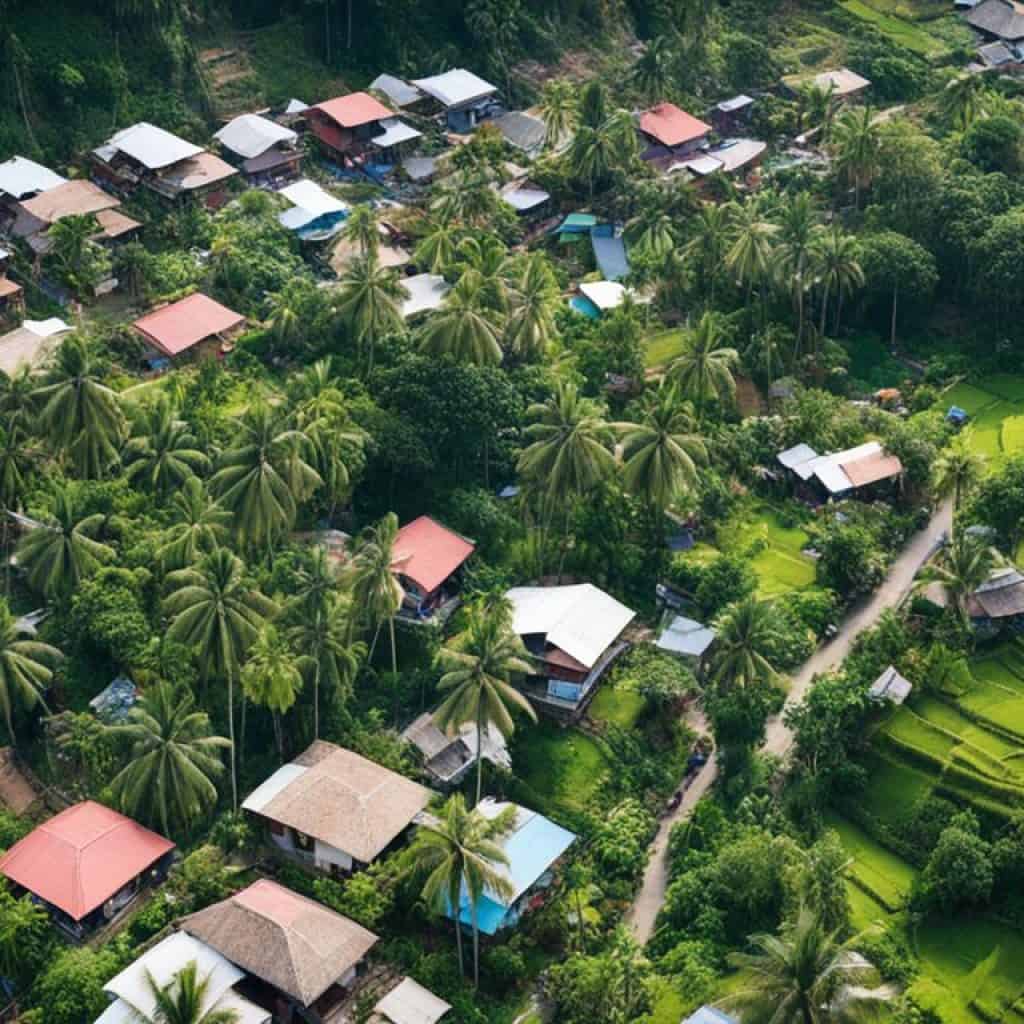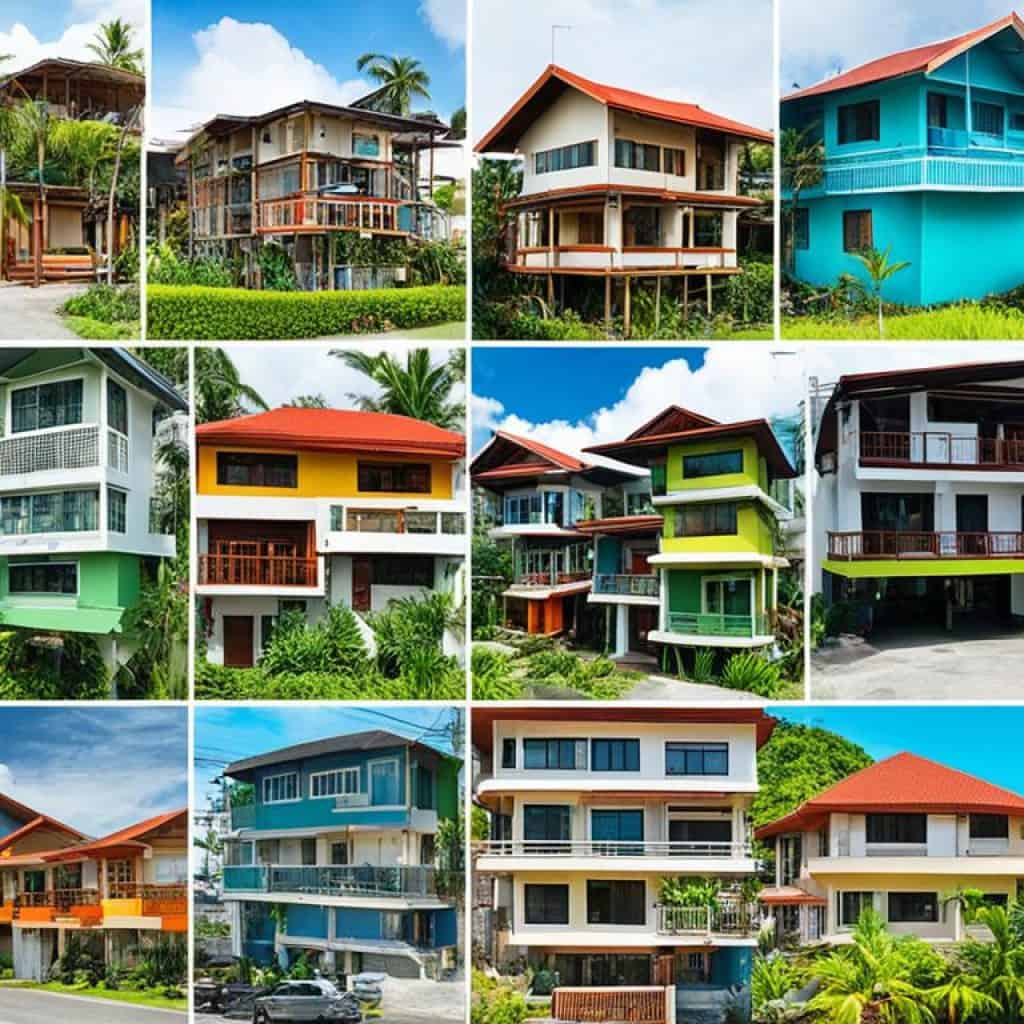Are you ready for an extraordinary adventure? Moving to the Philippines from the US offers a world of endless possibilities and new experiences. Whether you are looking to explore lush tropical landscapes, immerse yourself in a rich cultural heritage, or simply embrace a laid-back lifestyle, the Philippines is the perfect destination for you. But before you take the leap, there are important factors to consider and plan for to ensure a smooth and successful transition.
Key Takeaways:
- Research and understand the visa requirements for living in the Philippines as a US citizen.
- Familiarize yourself with the cost of living, housing options, healthcare system, and transportation in the Philippines.
- Consider the logistics and costs of international moving services to transport your belongings to the Philippines.
- Explore the unique opportunities and challenges of living in the Philippines, including education options and cultural immersion.
- Embrace the adventure and open yourself up to new experiences and a vibrant expat community in the Philippines.
Important Facts About the Philippines
Before moving to the Philippines, it’s important to familiarize yourself with some basic facts about the country. Here are some essential details:
Now, let’s delve into each of these aspects:
As you can see, the Philippines offers a diverse culture and a warm atmosphere that welcomes expats from all walks of life.
Can a US Citizen Live in the Philippines?
Planning to live in the Philippines as a US citizen? Good news! US citizens are allowed to legally move to the Philippines for a long-term stay. However, there are some important visa requirements to consider to ensure a smooth transition and compliance with immigration regulations.
Visa Options for US Citizens
If you’re considering a move to the Philippines, there are various visa options available depending on the purpose of your stay:
- Tourist Visa: If you plan to stay in the Philippines for less than 30 days, you can visit the country without a visa.
- Non-Immigrant Visa: For longer stays, you’ll need to obtain a non-immigrant visa. This includes options such as work visas, study visas, retirement visas, and visas for joining family members or a spouse living in the country.
- Special Resident Retiree’s Visa (SRRV): The SRRV is a popular choice for US citizens looking to retire in the Philippines. It offers long-term residency and various benefits for foreign retirees.
It’s important to carefully assess your purpose of stay and choose the visa that best suits your needs. Each visa has specific requirements, documentation, and application processes that must be followed.
Long-Term Stay in the Philippines
For a long-term stay in the Philippines, US citizens will need to comply with certain rules and regulations:
Once you have obtained the necessary visa, you are permitted to live in the Philippines for the duration specified in your visa. It’s important to note that visas are typically granted for a specific purpose and may include restrictions on employment or other activities. It’s crucial to abide by the terms and conditions of your visa to avoid any legal issues.
Living in the Philippines as a US citizen offers a unique cultural experience, affordable cost of living, and beautiful natural attractions. Just ensure you have the right visa in hand to make your stay legal and hassle-free.
| Visa Type | Requirements | Duration of Stay |
|---|---|---|
| Tourist Visa | – Valid passport – Return ticket – Proof of accommodation – Sufficient funds for the duration of stay | Up to 30 days |
| Non-Immigrant Visa | – Specific requirements depending on the visa type | Varies depending on the visa type |
| Special Resident Retiree’s Visa (SRRV) | – Proof of retirement and financial stability – Medical clearance – Other documentation as specified | Long-term residency |
Immigration and Visas in the Philippines
As a US citizen moving to the Philippines, you have a range of visa options to choose from. Depending on your purpose of stay, you can apply for different types of visas that suit your needs. Here are some of the main visa types available:
- Work Visa: If you plan to work for a Filipino company, you will need to apply for a work visa, which requires a work permit. This visa is suitable for individuals seeking employment opportunities in the Philippines.
- Student Visa: Foreign students accepted into a Filipino educational institution can apply for a student visa. This visa allows you to study in the Philippines and pursue your academic goals.
- Retirement Visa: The Special Resident Retiree’s Visa, also known as the retirement visa, is available to individuals over the age of 35 who wish to retire in the Philippines. This visa allows retirees to enjoy their golden years in the tropical paradise of the Philippines.
- Other Visa Types: In addition to work, student, and retirement visas, there are other visa types available, such as spouse visas and quote visas. These visas cater to specific circumstances and are designed to meet the different needs of individuals moving to the Philippines.
Each visa type has its own specific requirements and application process. It is important to thoroughly research and understand the visa requirements before applying. Seeking assistance from a professional immigration consultant or lawyer can help ensure a smooth and successful visa application process.
Note: The table below provides a summary of the various visa types available for US citizens moving to the Philippines.
| Visa Type | Description |
|---|---|
| Work Visa | A visa for those planning to work for a Filipino company. Requires a work permit. |
| Student Visa | A visa for foreign students accepted for a course of study at a Filipino educational institution. |
| Retirement Visa | A visa available to individuals over the age of 35 who wish to retire in the Philippines. Also known as the Special Resident Retiree’s Visa. |
| Spouse Visa | A visa for spouses of Filipino citizens or permanent residents in the Philippines. |
| Quote Visa | A visa for individuals invited or sponsored by a Filipino individual or organization for a specific purpose or event. |
Remember to consult the official websites or contact the Philippine embassy or consulate in your area for the most up-to-date information regarding visa requirements and application procedures.
Living in the Philippines: The Basics
Moving overseas always requires some adjustments, and living in the Philippines is no exception. As you settle into your new life, it’s important to familiarize yourself with the cost of living, housing options, healthcare system, and banking and taxation in the country.
Cost of Living in the Philippines
The cost of living in the Philippines is generally lower compared to the US, which can significantly benefit expats. Everyday expenses such as meals, groceries, and transportation are more affordable in the Philippines. For example, a three-course meal for two people can cost around $21.52, compared to $75 in the US, allowing you to enjoy a higher standard of living.
Moreover, housing in the Philippines is also more affordable compared to the US. Whether you choose to rent or buy property, you’ll find a range of options to suit your needs and preferences. Renting is a popular choice among expats as it offers flexibility and the opportunity to explore different areas before making a long-term commitment.

Healthcare in the Philippines
The healthcare system in the Philippines consists of both public and private healthcare providers. While public healthcare is available, it may not meet the standards expats are accustomed to. To ensure access to quality healthcare services, private healthcare is recommended. It’s advisable for expats to have health insurance to cover medical expenses and provide peace of mind.
Banking and Taxation in the Philippines
Opening a local bank account is necessary for managing your finances and making transactions in the Philippines. Most major banks accept online applications, making the process convenient. However, some banks may require an in-person visit for verification. ATMs are readily available in major cities, although fees may apply.
It is important to familiarize yourself with the taxation laws in the Philippines as they can vary depending on your income and residency status. Seeking professional advice will ensure compliance and help you make informed financial decisions.
Living in the Philippines offers an affordable cost of living, a range of housing options, quality healthcare, and a reliable banking system. Taking the time to understand these basics will contribute to a smooth transition and enjoyable expat experience in this beautiful country.
Cost of Living in the Philippines
The cost of living in the Philippines is significantly lower compared to the US, making it an attractive destination for those seeking affordable living expenses. Everyday expenses such as meals, groceries, and transportation are much cheaper in the Philippines.
Average Prices in the Philippines
Let’s take a closer look at the average prices in the Philippines:
Note: Prices may vary depending on the location and personal preferences.
The cost of renting an apartment in the Philippines is significantly lower compared to the US. This provides an opportunity for expats to find comfortable housing options without breaking the bank.
Living in the Philippines allows you to experience a more affordable lifestyle, where your budget can stretch further, and you can enjoy a higher quality of life without sacrificing your financial stability.
It is important to budget accordingly and consider your personal lifestyle and preferences when planning your cost of living in the Philippines. By understanding the average prices and making informed decisions, you can make the most of your experience in this beautiful country.
Cost of Moving to the Philippines
Before you embark on your new life in the Philippines, itâs important to consider the cost of actually moving there. This includes the shipping costs for your belongings and the flights for you and your family. The cost of shipping can vary depending on the size of your shipment and the method of transportation you choose.
If you plan to ship a full container from the US to the Philippines, the average cost ranges from $850 to $4,500. The exact price will depend on factors such as the distance, volume of goods, and any additional services required. Itâs advisable to obtain quotes from international moving services to compare prices and find the best option for your needs.
“Moving to the Philippines can be an exciting adventure, but itâs essential to factor in the cost of moving your belongings. Researching shipping costs and obtaining quotes from reliable international moving services will help ensure a smooth and budget-friendly transition.”
In addition to the shipping costs, donât forget to budget for flights to the Philippines. The price of airfare will depend on various factors such as the time of year, airline preferences, and departure location. Consider booking well in advance to secure the best deals.
Properly estimating the cost of moving to the Philippines will help you plan your budget and make the necessary arrangements for a successful relocation.
Housing in the Philippines
Finding suitable housing is an important aspect of moving to the Philippines. Whether you’re looking to rent a property or buy one, there are several housing options to consider. Renting is a popular choice among expats due to its flexibility and the opportunity to explore different areas before committing long-term. On the other hand, buying property in the Philippines can be an attractive option as property prices are generally more affordable compared to the US, presenting a great opportunity for real estate investment.
When it comes to housing options in the Philippines, there is a wide range of choices available to meet different needs and preferences. From apartments and condominiums to townhouses and detached houses, you can find a variety of housing styles and sizes. Whether you prefer a modern high-rise apartment in the heart of the city or a spacious house in a quieter suburban area, there are options to suit every lifestyle.
For those looking to rent in the Philippines, it’s worth noting that rental rates can vary depending on location, size, and amenities. The major cities, such as Manila and Cebu City, tend to have higher rental prices compared to smaller towns and rural areas. Renting a fully furnished property may be more convenient for expats as it saves the hassle of buying furniture and appliances.
Alternatively, if you’re considering buying property in the Philippines, it’s important to do thorough research and seek professional advice. The real estate market in the Philippines offers opportunities for investment, with a variety of options ranging from affordable housing projects to luxury properties. Keep in mind that foreigners are generally not allowed to own land in the Philippines, but they can own condominium units or houses on leased land.
Advantages of Renting in the Philippines
Advantages of Buying Property in the Philippines
Overall, both renting and buying property in the Philippines offer their own advantages, and the choice ultimately depends on your personal circumstances and preferences. Take the time to weigh the pros and cons of each option and consider factors such as budget, long-term plans, and lifestyle preferences.
Remember to consult with a reputable real estate agent or property specialist who can provide guidance and assistance throughout the process. With proper research and the right support, you can find the perfect housing option that suits your needs and ensures a comfortable and enjoyable stay in the Philippines.

Healthcare in the Philippines
The healthcare system in the Philippines consists of both public and private healthcare providers. While the public healthcare system is available and accessible to the general population, it has limitations and may not always meet Western standards. Expats, on the other hand, often opt for private healthcare services, which provide higher quality facilities and services.
Private healthcare in the Philippines offers a range of medical services, including specialist consultations, diagnostic tests, surgeries, and hospital admissions. Many private hospitals and clinics are equipped with modern medical equipment and staffed by highly skilled healthcare professionals. This ensures that expats receive the best possible care and treatment.
It is important for expats moving to the Philippines to have health insurance coverage. Health insurance not only provides financial security against unexpected medical expenses but also ensures access to quality healthcare services. With health insurance, expats can have peace of mind knowing that their medical needs will be taken care of.
| Public Healthcare in the Philippines | Private Healthcare in the Philippines |
|---|---|
|
|
Whether you choose public or private healthcare in the Philippines, it is important to research and find the best healthcare provider for your specific needs. Consultations with healthcare professionals and recommendations from other expats can help you make an informed decision.
Banking and Taxation in the Philippines
When moving to the Philippines, one of the most important aspects to consider is managing your finances and understanding the taxation laws in the country. This section will guide you through the process of opening a bank account and provide an overview of the taxation system in the Philippines.
Opening a Bank Account in the Philippines
Opening a local bank account in the Philippines is a crucial step for handling your financial transactions while living in the country. Most major banks in the Philippines offer online applications for convenience, but some may require in-person visits for verification purposes. It is advisable to research different banks and their services to find the one that suits your needs best.
Here is an overview of the steps involved in opening a bank account:
- Choose a bank: Research and compare different banks to find the one that offers the services you require. Consider factors such as fees, accessibility, and customer service.
- Prepare the required documents: Typically, you will need to provide a valid ID, proof of address, and a minimum initial deposit. The specific requirements may vary depending on the bank.
- Submit your application: Fill out the online application form or visit the bank in person to submit your application and documents.
- Verification and account activation: The bank will verify your documents and conduct any necessary background checks. Once approved, your account will be activated, and you will receive your account details.
Remember that while ATMs are readily available in major cities, transaction fees may apply. It is recommended to check with your bank regarding any charges for using ATMs in the Philippines.
Taxation in the Philippines
Understanding the taxation system in the Philippines is essential for maintaining compliance and managing your finances effectively. The tax laws in the Philippines can vary depending on your income and residency status. It is recommended to consult with a tax professional to ensure proper handling of your tax obligations.
The key points to note about taxation in the Philippines include:
- Income tax: Resident individuals are taxed on their worldwide income, while non-resident individuals are taxed only on their income derived from sources within the Philippines. The tax rates vary based on income brackets.
- VAT (Value Added Tax): VAT is a consumption tax imposed on the sale of goods, services, and properties in the Philippines. The current rate is 12%.
- Withholding tax: This is a tax deducted by employers, banks, and other entities on behalf of individuals for income received. The rates depend on the type of income and applicable tax treaties.
- Property tax: Property owners in the Philippines are subject to property taxes, which are imposed by the local government where the property is located.
It is crucial to keep accurate records of your income and expenses to facilitate tax filing and ensure compliance with the tax laws of the Philippines.
| Tax Type | Tax Rate |
|---|---|
| Income Tax | Progressive – Rates range from 0% to 35% based on income brackets. |
| VAT | 12% |
| Withholding Tax | Rates vary based on the type of income and applicable tax treaties. |
| Property Tax | Varies based on the local government where the property is located. |
Education in the Philippines
The education system in the Philippines is based on the American model, providing a familiar framework for students. English is widely spoken, making it easier for expat children to adapt to their new school environment. In the Philippines, you’ll find a mix of public and private schools, as well as international schools that cater to expat students.
The school year in the Philippines typically runs from June to March, with students enjoying a summer break from April to May. Classes are taught in both English and Filipino, giving students the opportunity to learn and appreciate the local language and culture while still being able to communicate effectively in English.
Choosing the best education option for your children is an important decision. Public schools in the Philippines are funded by the government and provide free education, but they may have limited resources and larger class sizes. Private schools, on the other hand, offer smaller class sizes and often have better facilities and curriculum options, but they come at a higher cost.
For expat families who value an international curriculum and a diverse student body, international schools in the Philippines are a popular choice. These schools offer a globally recognized education and usually follow a curriculum such as the International Baccalaureate (IB) or the American curriculum. They provide a smooth transition for expat children and ensure continuity in their education.
It is essential to research and visit schools to get a better understanding of their educational philosophy, teaching methods, and extracurricular activities. This will allow you to make an informed decision and choose the best education option that aligns with your preferences and your children’s needs.
Pros and Cons of Education Options in the Philippines
| Educational Option | Pros | Cons |
|---|---|---|
| Public Schools | – Free education – Exposure to local culture – Opportunities to interact with local students | – Limited resources – Larger class sizes – Potential language barrier for non-Filipino students |
| Private Schools | – Smaller class sizes – Better facilities and resources – More curriculum options | – Higher cost – Less exposure to local culture – Potentially less diverse student body |
| International Schools | – Globally recognized education – International curriculum – Diverse student body | – Higher cost – Limited interaction with local students – Availability and admission criteria may vary |

Choosing the right education option for your children is crucial to ensure their academic growth and overall well-being. Consider their individual needs, your budget, and the long-term goals you have for their education. Whether you opt for a public, private, or international school, the Philippines offers a range of options that can cater to your family’s educational preferences.
Getting Around in the Philippines
Navigating transportation in the Philippines can be challenging due to the country’s unique geography. However, various options are available to help you get around and explore this beautiful archipelago.
Public Transportation
The cities, such as Manila, offer a range of public transportation options, making it easy to navigate through the bustling streets. Buses, jeepneys (colorful public utility vehicles), tricycles, and taxis are commonly used modes of transport. This diverse array of options allows you to choose the most convenient and affordable method for your needs.
Domestic Flights
If you plan to travel between different islands in the Philippines, domestic flights are the primary mode of transportation. With numerous airlines operating regular flights to popular destinations, you can easily hop from one island to another and experience the country’s diverse landscapes and cultures.
Driving in the Philippines
While it is possible to rent a car and drive in the Philippines, it is generally not recommended due to congested roads and varying road conditions. Traffic can be heavy, especially in major cities, and road signage may not always be clear. Additionally, driving habits and regulations may differ from what you are accustomed to. Instead, consider utilizing public transportation or hiring a local driver to navigate the roads for you.
It is important to plan your travel in advance and be aware of local transportation options. Whether you choose public transportation or domestic flights, getting around in the Philippines allows you to experience the country’s natural wonders and vibrant culture.
Moving to the Philippines with Eurosender
When it comes to moving your belongings to the Philippines, Eurosender provides reliable and affordable international removal services. Whether you are shipping a few suitcases or a full container, Eurosender can help you transport your belongings safely and efficiently. With competitive prices and insured shipments, Eurosender takes the stress out of moving to the Philippines.
With Eurosender’s international removals to the Philippines, you can choose from a range of shipping options tailored to your needs. Whether you need air freight for urgent and time-sensitive deliveries or sea freight for larger shipments, Eurosender has you covered. They work with trusted logistics partners to ensure that your belongings are handled with care and delivered to your new home in the Philippines on time.
No matter the size or weight of your shipment, Eurosender provides door-to-door service, meaning that they will pick up your belongings from your current location and deliver them directly to your new address in the Philippines. This eliminates the need for you to coordinate multiple logistics providers and ensures a seamless and hassle-free moving experience.
In addition to their reliable shipping services, Eurosender offers comprehensive insurance coverage for your belongings during transit. This gives you peace of mind knowing that your items are protected in case of any unforeseen circumstances. Eurosender’s dedicated customer support team is also available to assist you throughout the entire shipping process, ensuring that all your questions and concerns are addressed promptly.
Why choose Eurosender for your international removals to the Philippines?
With Eurosender’s international removal services, you can focus on the excitement of your move to the Philippines without worrying about the logistics of shipping your belongings. Trust Eurosender to handle your international removals to the Philippines with professionalism and efficiency.
Conclusion
Moving to the Philippines from the US offers an incredible opportunity to embark on a new adventure and embrace a different way of life. By carefully planning your relocation and familiarizing yourself with the country’s visa requirements, cost of living, housing options, healthcare system, and transportation, you can ensure a smooth transition and settle into expat life in the Philippines.
Whether you are moving for work, family, or retirement, the Philippines has so much to offer. From its stunning natural beauty and vibrant culture to its warm and welcoming people, it’s a country that will captivate you from the moment you arrive. Whether you’re exploring the idyllic beaches, immersing yourself in the rich history, or indulging in the delicious cuisine, every day in the Philippines is an opportunity for new discoveries.
Make the most of your time in the Philippines by embracing the unique experiences and opportunities it presents. From enjoying the bustling city life in Manila to venturing into the lush countryside, each region has its own charm and appeal. Immerse yourself in local traditions, connect with the community, and embrace the laid-back lifestyle that the Philippines is known for.
Relocating to the Philippines is a chance to create lasting memories and forge new friendships. With its friendly and hospitable people, you’ll find yourself surrounded by a supportive community that will help you navigate through the challenges of adjusting to a new country. So, take the leap and start your exciting chapter in the Philippines – a place where adventure, beauty, and warm hospitality await you.
FAQ
Can a US citizen live in the Philippines?
Yes, US citizens can legally move to the Philippines for a long-term stay.
What are the visa requirements for US citizens in the Philippines?
US citizens can choose from various visa types, including work visa, student visa, retirement visa, spouse visa, and quote visa.
What is the cost of living in the Philippines compared to the US?
The cost of living in the Philippines is generally lower compared to the US. Prices for everyday expenses such as meals, groceries, and transportation are significantly cheaper.
How much does it cost to ship belongings to the Philippines?
Shipping costs can vary depending on the size of the shipment and the method of transportation. On average, you can expect to pay between $850 and $4,500 to ship a full container from the US to the Philippines.
What are the housing options in the Philippines?
What is the healthcare system in the Philippines like?
The healthcare system in the Philippines consists of both public and private healthcare providers. Expats typically opt for private healthcare, which offers higher quality facilities and services. It is recommended to have health insurance to cover medical expenses and ensure access to quality healthcare services.
How do I open a bank account in the Philippines?
Opening a local bank account in the Philippines is essential for managing your finances and making transactions. Most major banks accept online applications, but some may require in-person visits for verification.
What is the education system like in the Philippines?
The education system in the Philippines is based on the American model, and English is widely spoken. There are both public and private schools, as well as international schools that cater to expat students.
What are the transportation options in the Philippines?
Cities like Manila offer various options for public transportation, including buses, jeepneys, tricycles, and taxis. Domestic flights and ferries are the primary modes of transportation for travel between islands. Driving in the Philippines is not recommended due to congested roads and varying road conditions.
How can Eurosender help with moving to the Philippines?
Eurosender provides reliable and affordable international removal services for moving to the Philippines. Whether you are shipping a few suitcases or a full container, Eurosender can help you transport your belongings safely and efficiently.


















Add comment